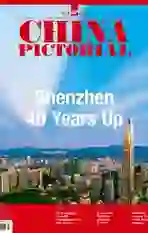Shenzhen Dreamers’Heaven
2018-08-06byShiLei
by Shi Lei
Twenty-eight years ago when I first arrived in Shenzhen, only a single bus line reached the Shekou Industrial Zone from the Luohu Railway Station, and a single trip took two hours. In those days, only small private stores sold electric appliances like televisions and refrigerators and offered no warranties or repair service. Even so, many young people like myself chose to stay because the city was totally different from Chinas inland cities. Despite its rustic qualities, it gave us hope—hope to change our lives.
In the early 1980s when the Shenzhen Special Economic Zone was first built, manufacturing enterprises from Hong Kong and Taiwan dominated the place. In the 1990s, considering its limited territory, Shenzhen eyed upgrading its industry to high-tech realms that require smaller spaces, emit less pollution and have greater added value. But the city lacked colleges, institutes and a talent pool. So the municipal government of Shenzhen invited some inland universities to establish research institutions in the city. At the end of 1996, the first local academy—Research Institute of Tsinghua University in Shenzhen—was launched jointly by the Shenzhen municipal government and Tsinghua University. The former invested 80 million yuan in the construction of the institute, a big expenditure for a government whose total annual revenue was only 3.7 billion yuan at that time.
Thanks to the sound academic and industrial environment of Shenzhen and Guangdong Province, this new type of research and development institutes enjoyed rapid growth. Tsinghua University has taken advantage of its alumni resources and global reach to help its graduates win support from the Shenzhen municipal governments “Phoenix Program”and Guangdong Provinces “Pearl River Plan” and built a platform to help overseas graduates return to start business. In recent years, the institute has produced five teams that have won grants under the “Phoenix Program” and three teams for projects under the “Pearl River Plan,” not only enhancing its research level but also accumulating industrial strength for the city and the province. The city hopes all of these teams will become high-tech giants in the future.
Today, more than 60 universities from around China and the world have set up research institutions in Shenzhen. Over the past two decades, the local government launched a series of plans to attract high-caliber professionals by providing subsidies to new graduates. Shenzhen is now home to more than 20 million residents, ten times more than the population in the 1990s. And the average age of its population is only 30 years old. The influx of so many young people has injected considerable vigor and creativity into the city. A true immigrant town, Shenzhen is so inclusive that everyone strives for a common goal and easily reaches consensus.
Adhering to its original aspiration to become a high-tech city, Shenzhen has evolved into an advanced technology hub. Radiating from the high-tech industrial park in its Nanshan District, Shenzhen High-tech Industrial Zone now houses over 60 institutes and headquarters of many elite hightech enterprises like Tencent and DJI. Thousands of such companies operate in the area covering only several square kilometers but create a total industrial output worth thousands of billions yuan. The high-tech industrial park in Nanshan District alone hosts 150 listed companies, over 80 percent of which are high-tech firms.
Over the past 20 years, Shenzhen has become the top destination for innovative startups. It has become the city for dreamers due to its sound market environment, advanced model of governance, preferential industrial policies, perfect industrial support and chains, abundant private investment capital and special culture of an immigrant city. These factors have also fueled Shenzhens miraculous growth in the past few decades.
